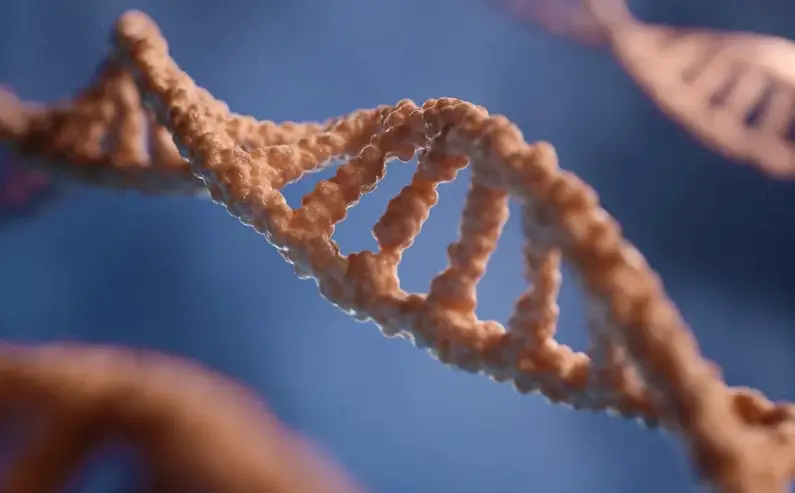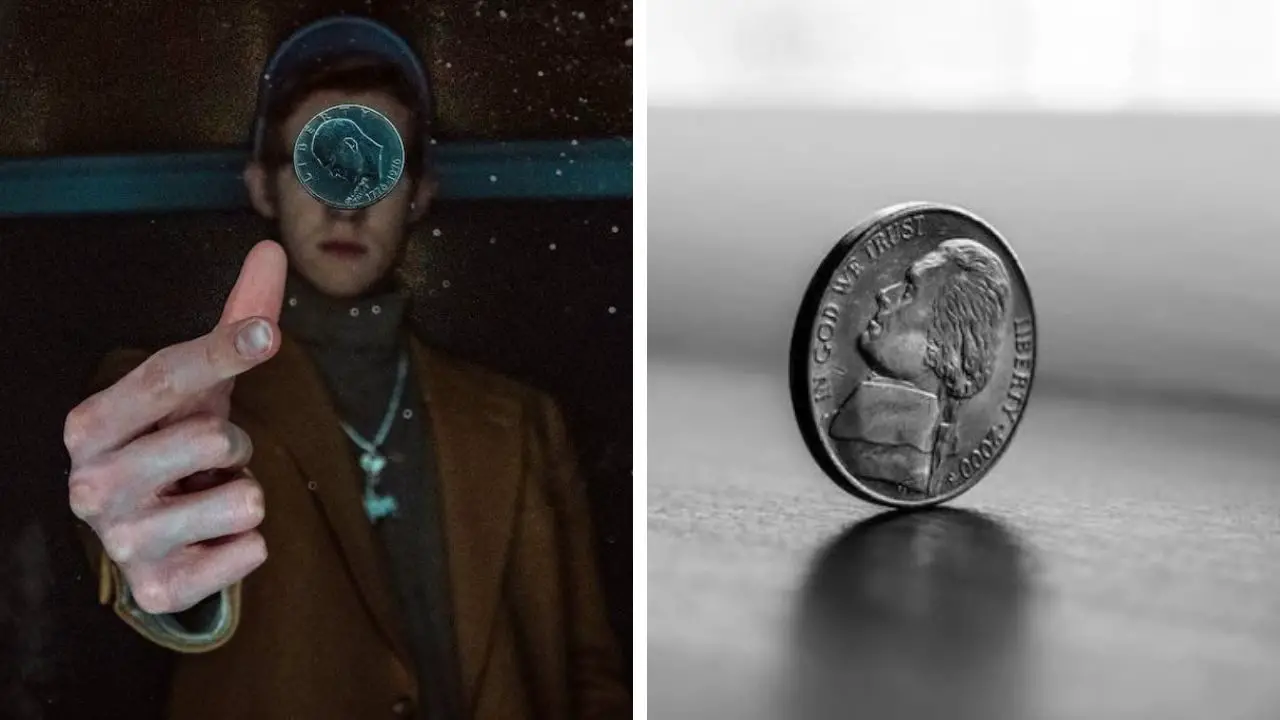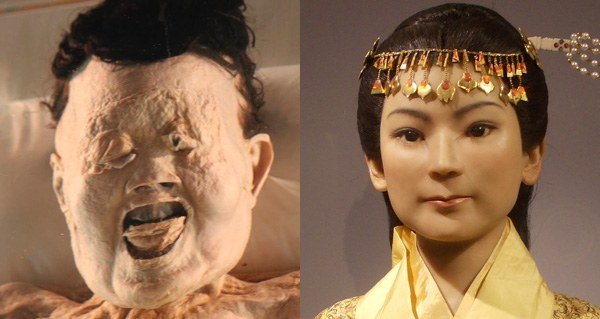The Enchanting Rainbow Eucalyptus: Nature’s Masterpiece of Color
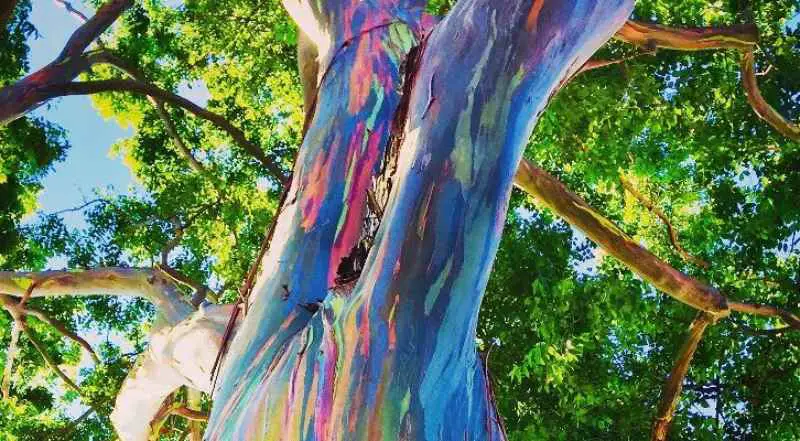
In the lush rainforests of the tropics, one tree stands out like a living canvas. The Rainbow Eucalyptus (Eucalyptus deglupta), also called the Mindanao gum or rainbow gum, captivates with its vibrant, multicolored bark.
Its trunk, adorned with streaks of green, red, orange, purple, and brown, looks like a painter’s masterpiece.
This article explores why the Rainbow Eucalyptus bark is so colorful, its ecological role, cultural significance, cultivation challenges, and the efforts to protect this natural wonder.

A Kaleidoscope of Colors
The Rainbow Eucalyptus is renowned for its breathtaking bark, which displays a spectrum of colors unlike any other tree.
The secret lies in its unique shedding process. As the tree grows, its smooth, orange-tinted bark peels away in thin strips.
This reveals a bright green inner layer, rich in chlorophyll. Over weeks, this layer matures, transforming into shades of red, orange, purple, and brown.
Each tree’s pattern is unique, as the shedding occurs at different times across the trunk, creating a patchwork of colors that shifts with the seasons.
This phenomenon is not artificial. It’s a natural process driven by the tree’s biology and environmental interactions.
The bark’s vibrant display has made the Rainbow Eucalyptus a favorite in botanical gardens and tropical landscapes worldwide.

The Science Behind the Colors
The color changes in the Rainbow Eucalyptus bark are a result of pigment interactions and environmental exposure.
When the outer bark sheds, the exposed inner bark is rich in chlorophyll, giving it a vivid green hue.
As this layer ages, chlorophyll breaks down, and other pigments take over. Anthocyanins produce reds and purples, while carotenoids contribute oranges and yellows.
These pigments react to sunlight and air, causing the gradual color shift. By the time the bark turns brown, it’s ready to shed again, restarting the cycle.
This process is akin to the color changes in autumn leaves, but it happens continuously on the Rainbow Eucalyptus.
Unlike the bark, the inner wood remains white, lacking the pigments that create the rainbow effect.
This distinction is important for those hoping to use the wood for colorful projects, as the vibrant hues are exclusive to the bark.
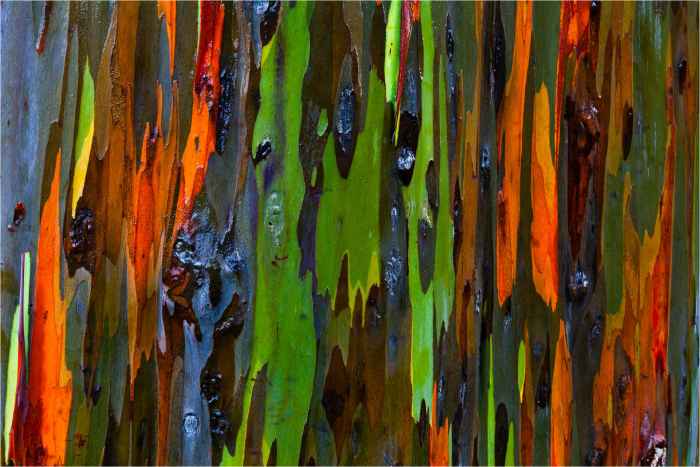
Natural Habitat and Distribution
The Rainbow Eucalyptus is native to the tropical rainforests of the Philippines, Indonesia, Papua New Guinea, and Timor Leste.
It thrives in lowland and lower montane forests, from sea level to altitudes of 1,800 meters (5,906 feet).
Unlike other eucalyptus species, which are mostly found in Australia, this tree is unique as the only eucalyptus naturally occurring in the Northern Hemisphere’s rainforests.
In the Philippines, it’s known as “bagras,” particularly on the island of Mindanao.
These trees can grow to towering heights of 60–78 meters (197–256 feet), with trunks up to 240 cm (94 inches) in diameter.
Their large buttresses and rapid growth make them a vital part of rainforest ecosystems, providing structural stability and habitat for wildlife.
Cultivation Challenges and Global Spread
The Rainbow Eucalyptus’s striking appearance has led to its cultivation beyond its native range.
It’s grown as an ornamental tree in places like Hawaii, southern Florida, California, Texas, Brazil, and parts of Africa.
However, it requires specific conditions to thrive. The tree prefers warm, humid climates and cannot tolerate frost, making it suitable only for USDA hardiness zones 10 and 11.
In the U.S., it typically reaches 100–125 feet (30–38 meters), shorter than in its native environment.
Cultivating Rainbow Eucalyptus can be challenging. It needs full sun and well-drained soil, and its rapid growth—up to three feet per year—requires ample space.
In some regions, like Florida, it’s considered invasive due to its fast growth and robust root systems, which can outcompete native plants.
Gardeners must weigh its beauty against potential ecological impacts.
| Aspect | Details |
|---|---|
| Common Names | Mindanao Gum, Rainbow Gum, Bagras |
| Mature Height | 60–78 m (197–256 ft) in native range; 30–38 m (100–125 ft) in U.S. |
| Mature Width | 20–30 ft |
| Sunlight | Full Sun |
| Growth Rate | Fast, up to 3 ft per year |
| Botanical Name | Eucalyptus deglupta |
| Growing Zones | 10–11 (frost-free) |
| Uses | Ornamental, pulpwood, medicinal |
Ecological Role and Conservation Concerns
In its native rainforests, the Rainbow Eucalyptus plays a critical ecological role. Its towering height and large size provide structural support to forest ecosystems.
The tree offers habitat and food for birds, insects, and small mammals.
Its leaves, rich in volatile organic compounds called terpenoids, sometimes create a hazy, aromatic mist in forests, adding to its mystique.
However, the Rainbow Eucalyptus faces conservation challenges. Logging for pulpwood, used to produce white paper, has reduced its global population by about 30% in recent decades.
Deforestation and climate change further threaten its natural habitats. Conservation efforts focus on sustainable forestry and protecting rainforest ecosystems.
Initiatives in the Philippines and Indonesia aim to balance commercial use with preservation, ensuring this species survives for future generations.
Watch! It’s Fantastic to Grow RAINBOW Eucalyptus Trees
Medicinal and Cultural Significance
The Rainbow Eucalyptus is more than a visual marvel; it holds cultural and medicinal value, especially in its native regions.
In the Philippines, where it’s called “bagras,” indigenous communities have long used its leaves for their antiseptic properties.
These leaves treat wounds, coughs, asthma, and respiratory ailments. The essential oil extracted from the leaves is used in aromatherapy for its anti-inflammatory and relaxing effects.
Studies suggest the oil may also have antibacterial properties, supporting its traditional use in treating infections.
The tree’s ability to repel mosquitoes enhances its practical value in tropical areas.
Its wood, while primarily used for pulp, is also employed in furniture, flooring, and construction in some regions, though its value as pulpwood often overshadows other uses.
Culturally, the Rainbow Eucalyptus is revered as a symbol of beauty and resilience, featured in local folklore and modern landscaping.
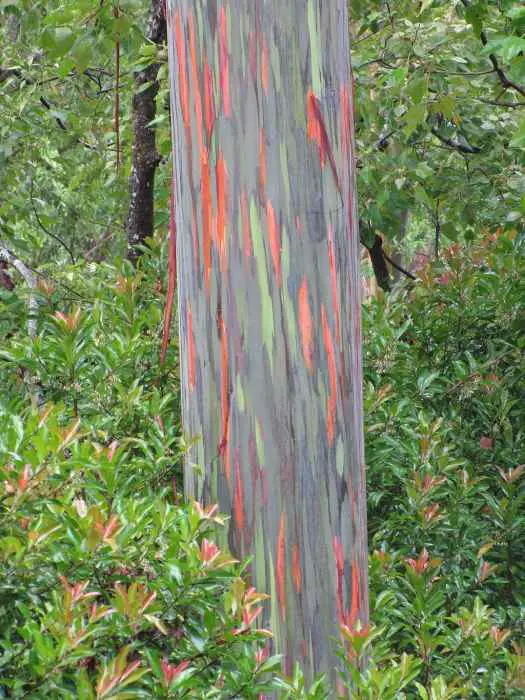
A Global Symbol of Beauty
Beyond its native range, the Rainbow Eucalyptus has become a global icon of natural beauty.
Its vibrant bark makes it a popular choice for botanical gardens, parks, and streetscapes in tropical and subtropical regions.
Photographers and artists draw inspiration from its kaleidoscopic patterns, and it’s often featured in travel and nature publications.
However, its introduction to new regions requires careful management to prevent it from becoming invasive.
Its colorful bark, driven by a unique shedding process and pigment interactions, sets it apart as one of the world’s most stunning trees.
Beyond its beauty, it plays vital ecological, medicinal, and cultural roles.
As conservation efforts continue, this remarkable species reminds us of the importance of protecting our planet’s biodiversity.
Whether in a rainforest or a botanical garden, the Rainbow Eucalyptus continues to inspire awe and wonder.













